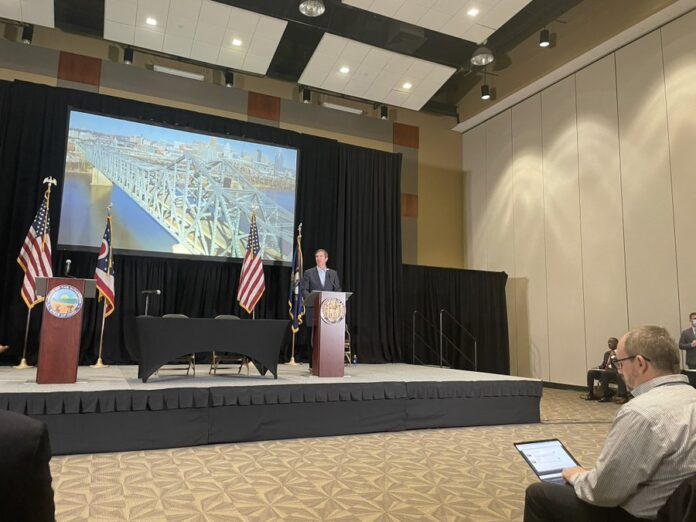Your donation will support the student journalists of Northern Kentucky University. Your contribution will allow us to purchase equipment and cover our annual website hosting costs.
Funding for Brent Spence Companion Bridge clears hurdles in Kentucky Legislature
March 30, 2022
In February, Gov. Beshear joined Ohio Gov. Mike DeWine at the Northern Kentucky Convention Center to sign a Memorandum of Understanding.
Funding for the Brent Spence Bridge corridor project took two crucial steps Tuesday. House Bill 242, which is the House Biennial Highway Construction plan, passed the Senate Transportation Committee.
The Budget Conference Committee also moved forward its budget, including $250 million in matching funds from the General Fund for the project.
House Bill 242 now heads to the Senate and then back to the House for concurrence. The Senate also has to vote on the budget, and it will follow the same process as HB242, with a vote on the Senate floor likely to occur on Tuesday. Once clear of both chambers, the bills will head to the governor’s desk.
In January at Gov. Andy Beshear’s budget address, he mentioned $250 million that would be pulled from the General Fund for “megaprojects,” which includes the Brent Spence Bridge. He also reiterated that the bridge would be without tolls, something that’s been important to Northern Kentucky legislators.
“We are using a one-time fund so we can push ahead our application to the Federal government on the Brent Spence bridge,” Beshear said in his budget release.
The application to the federal government has been the piece that’s holding up the process, according to Rep. Sal Santoro (R-Union), who has worked on this portion of the House Budget. The money from the federal government is coming from the Infrastructure Bill that passed Congress last year. Of these funds, $39 billion is set aside for bridge projects.
“I want to let everyone know we are still waiting for direction from Washington on infrastructure spending,” Santoro said in the House committee meeting last week. “That is why we’ve been delaying … we still don’t know where things are going on the big items.”
The Commonwealth applied for $2 billion in federal funding for the Brent Spence project. The project’s estimated cost is $2.8 billion, leaving roughly $800 million to be covered by the States of Kentucky and Ohio.
“The total cost of this is $2.8 billion, and Kentucky provides $1.3 billion of this,” Santoro said in a committee meeting. “This is over a few years. We are working with Ohio.”
In February, Gov. Beshear joined Ohio Gov. Mike DeWine at the Northern Kentucky Convention Center to sign a Memorandum of Understanding. The agreement, which previous governors had symbolically completed, would allow Kentucky and Ohio to align on the project. The MOU would show the federal government that the states are serious about getting the project over the line.
“We believe this is one significant step forward to building a new bridge and improve the current bridge,” DeWine said at the time. “I don’t have to tell anybody in this room the importance of the bridge.”
Ohio will likely also put forward some money, according to Kentucky State Sen. Jimmy Higdon (R-Lebanon), who presented HB242 to the Senate Transportation Committee.
“Personally, I think the entire federal grant was set up to accommodate the Brent Spence Bridge,” Higdon said. “Hopefully, they’re eager to award that and get it started.”
Even without a contribution, Ohio Director of Transportation Jack Marchbanks did give some details on the timeline, saying they hope to have design plans for the project by the fall of 2023.
“If we do get grant funding by the end of this year, our goal is to have a design procurement package by fall of 2023,” Marchbanks said. “We’re looking at five years. That’s a conservative estimate.”
While the project timeline is still in the air, especially since there’s so much to be determined on the federal level, Gov. Beshear mentioned in January that he wants an aggressive approach to the project.
“Can I just add? I want us to break ground next year. It’s time. I know it’s aggressive,” Beshear said at the time. He is up for reelection in 2023.
The final matching funds from the House and Senate budgets are $250 million. This is more than the $200 million proposed in the Senate budget but equal to Gov. Beshear’s budget proposal. After the budget conference committee’s last meeting Tuesday, Sen. Chris McDaniel (R-Taylor Mill) noted that they were able to settle on the higher number after discussions.
“The governor originally had that number, and they came to us after the product had cleared both chambers and said that it was their belief that would be the most competitive when they put the grants into the federal government,” McDaniel said.
The story was originally published on LINK nky. The link to the original article can be found here.

